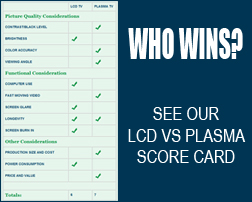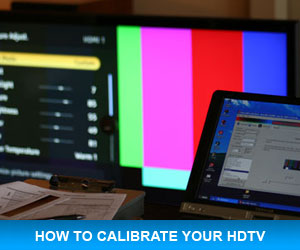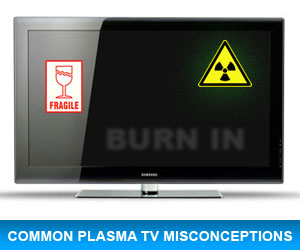This is the #1 question for me at any gathering: Which is better, LCD TV or Plasma? This is a much debated topic and a fun one. When choosing between plasma and LCD TVs, you're actually selecting between two competing technologies, both of which achieve similar features (i.e., ,bright crystal-clear images, super color-filled pictures) and come in similar packages (i.e., 1.5 to 4 inch depth flat screen casing). To complicate the decision-making process further, price and size are two previous considerations that are rapidly becoming non-issues as LCD TVs are now being made in larger sizes and at competing prices with plasma.
| ||||||||||||||||||||||||||||||||||||||||||||||||||||||||||||||||||||||
Plasma technology consists of hundreds of thousands of individual pixel cells, which allow electric pulses (stemming from electrodes) to excite rare natural gases-usually xenon and neon-causing them to glow and produce light. This light illuminates the proper balance of red, green, or blue phosphors contained in each cell to display the proper color sequence from the light. Each pixel cell is essentially an individual microscopic florescent light bulb, receiving instruction from software contained on the rear electrostatic silicon board. Look very closely at a plasma TV and you can actually see the individual pixel cell coloration of red, green, and blue bars. You can also see the black ribs which separate each.
Whether spread across a flat-panel screen or placed in the heart of a projector, all LCD displays come from the same technological background. A matrix of thin-film transistors (TFTs) supplies voltage to liquid-crystal-filled cells sandwiched between two sheets of glass. When hit with an electrical charge, the crystals untwist to an exact degree to filter white light generated by a lamp behind the screen (for flat-panel TVs) or one projecting through a small LCD chip (for projection TVs). LCD monitors reproduce colors through a process of subtraction: They block out particular color wavelengths from the spectrum of white light until they're left with just the right color. And, it's the intensity of light permitted to pass through this liquid-crystal matrix that enables LCD televisions to display images chock-full of colors-or gradations of them.
LED TVs are a new form of LCD Television. The panel on an LED TV is still an LCD TV panel and operates the with the same twisting crystals matrix. The backlight is the difference - changing from flourescent to LED (light emitting diode) based backlighting. See our complete coverage of LED TV articles and models here.
PICTURE QUALITY CONSIDERATIONS
CONTRAST / BLACK LEVELSPlasma technology has certainly achieved quite high contrast ratios, a measure of the blackest black compared to the whitest white. Many plasma display manufacturers boast a contrast ratio of 40,000:1 these days though our tests using a standardized ANSI checkerboard pattern have not proven these numbers out. Plasma displays achieve such impressive black levels by using internal algorithms to block the power to particular pixels in order to render a pixel "dark" or black. While this can limit a plasma television's gray scaling, it does produce exceptionally black blacks - depending on the manufactured plasma display element (i.e. glass). A plasma TV uses maximum power when it is producing full white. As a result, some 2nd tier manufactured brands of plasma TVs have an audible buzz or whining sound when displaying white or very light images.
LCD (liquid crystal diode) displays, by contrast, utilize electric charges to twist and untwist liquid crystals, which causes them to block light and, hence, emit blacks. The higher the voltage passing through the liquid crystals in a given pixel, the more fully those crystals untwist and effectively block light - all of which makes these pixels darker. As opposed to plasma, LCD TVs use the most power when displaying a very dark or black image. This is a difficult process, and despite recent improvements in LCD black levels, only the best LCD televisions have managed to come close to plasma technology in contrast ratio. The one continual drawback here for LCD is off axis viewing, when black levels consistently drop. We have noted some improvement from LCD manufacturers lately in off axis viewing contrast.
ADVANTAGE: Closer than a year ago, but still Plasma. LCD TV manufacturers have made great improvements in black levels and in many cases have nearly managed to match the contrast ratio of plasma TVs. However, Plasma displays still maintain a clear advantage in this category due to fading blacks when viewing LCDs from off axis. For scenes with a lot of dark and light images shown simultaneously - as with content originating from DVDs, video games, and NTSC TV signals - plasmas still consistently outperform LCD TVs.
COLOR ACCURACY
TOP 10 Best Selling LCD TVS | |
| 1 | Samsung LN32C350 |
| 2 | Sony KDL-52EX700 |
| 3 | Samsung UN46C6500 |
| 4 | Samsung LN32C450 |
| 5 | Samsung LN40C650 |
| 6 | LG 32LD550 |
| 7 | Samsung UN46C7000 |
| 8 | Sony KDL-46EX500 |
| 9 | Sharp LC46LE820 |
| 10 | LG 47LE5500 |
Last Update: | |
LCD TVs reproduce colors by manipulating light waves and subtracting colors from white light. This is an inherently difficult template for maintaining color accuracy and vibrancy - though most LCD TVs manage quite well. While color information benefits from the higher-than-average number of pixels per square inch found in LCD televisions (especially when compared to plasmas), LCDs are simply not as impressive as plasmas with similar pixel counts. LCDs however, produce a typically brighter picture. Greens sometimes look oversaturated and reds can run a bit warm, but in a room with lots of ambient light coming in from windows, an LCD TV would be my choice.
ADVANTAGE: Preference to plasma but depends upon room light, manufacturer and model. Plasma TV color richness and naturalness will prevail in rooms with lower to normal lighting. LCD TVs perform better in very brightly lit rooms due to their inherent anti glare technology and brightness.
VIEWING ANGLES
Plasma manufacturers have made much of their near perfect 180 degree viewing angles, which is about as good as horizontal and vertical viewing angles get. This owes to the fact that each pixel produces its own light, rather than light being spread across the screen from one central source. Hence, each pixel is more readily visible because its brightness is consistent with every other pixel on the screen. One consistent area of superiority of plasma viewing angles is demonstrated when viewing dark material content, especially DVDs. A Plasma display holds the black levels from off axis, while LCD TVs lose black level intensity/contrast more as the angle off axis increases. This usually occurs after around 45 degrees off center.
LCD TV manufacturers have done much to improve their displays' viewing angles. The substrate material on newer-generation LCD models by Sharp and Sony has helped to expand those units' viewing angles, though they still have some ground to cover before catching plasma. Expect the best LCD HDTVs to have around 120 degree viewing angles.
ADVANTAGE: Plasma
FUNCTIONAL CONSIDERATIONS
COMPUTER USEGenerally the performance should be about the same in terms of displaying the video image provided that the resolution of the plasma or LCD TV is 1080p or higher. Some plasma TVs still have 720p resolution and this would be a drawback to a defined static image.
Burn in is the second factor. Though plasma TVs have substantial anti-burn in technology built in these days, there is still some risk there.
ADVANTAGE: LCD
FAST-MOVING VIDEO PLAYBACK
Plasma technology gets the easy nod here because of their excellent performance with fast-moving images and high contrast levels. It's an inherent quality of the technology. There are still some 2nd tier plasma manufacturers whose plasma TVs display some phosphor lag, a drag time in scenes changing from bright to dark.
While the "response time" of LCD TVs has markedly improved in the last couple of years, they still suffer from a slight "trailer" effect, where the individual pixels are just slightly out of step with the image on the screen. During fast moving scenes, the most discerning eyes can detect this slight motion response lag. Motion lag may also be detected on LCD TVs when the camera pans from side to side sometimes appearing to stutter or jerk. This applies to both flourescent backlit LCDs and LED backed LCDs.
LCD TV manufaacturers have worked hard to overcome the motion lag issue. Last years models saw the introduction of 120Hz refresh rate (up from 60). This year many models were introduced with 240Hz refresh rate. This refresh rate has drastically improved the response time. However, it also introduces unwanted video information by sharpening the picture background information and taking out necessary blur. This may seem like a positive, but with 90% of your viewing material, it is not. Depending upon the manufacturer, we advise turning off the 120Hz or 240Hz feature with all but live sports programming. See our full article about 120Hz/240Hz refresh rate here.
Please read the following reviews if you would like more information on how the 120Hz/240Hz feature works for specific models:
- Samsung LN52B750 Review
- Sony KDL-52XBR9 Review
- LG 47LH55 Review
- Samsung UN55B8000 Review
- Sharp LC-52E77U Review
- Sony KDL-55XBR8 Review
- Toshiba Regza 46XV645U Review
HIGH ALTITUDE
There is a reason LCD flat panels are the preferred visual display units for use on airplanes: LCD TVs aren't affected by increases or decreases in air pressure. Their performance is consistent regardless of the altitude at which they're utilized.
This is not the case for a plasma. The display element in plasma TVs is actually a glass substrate envelope with rare natural gases compressed therein. So, at high altitudes (6,500 feet and above), an air-pressure differential emerges, which causes plasma displays to emit a buzzing sound due to the lower air pressure. This noise can sound rather like the humming of an old neon sign. NEC has been effective in producing several plasma models that are rated to 9,500 feet.
ADVANTAGE: LCD, at 6,500 feet and higher.
LONGEVITY
LCD television manufacturers claim that their displays last, on average, 60,000. In fact, an LCD TV will last as long as its backlight does. Since this is nothing more than light passing through a prismatic substrate, there is little to wear out in an LCD TV except the backlighting. However, one nasty little known fact about LCD technology is that as the flourescent backlight ages it can change colors slightly (think of florescent bulbs in office lighting). When this occurs the white balance of the entire LCD TV will be thrown for a loop and the user will need to re-calibrate the TV. Some of the early purchasers of larger LCD screens will be learning this tidbit in a couple of years. From our research, flourescent bulb backlighting in LCDs cannot be replaced cost effectively. LED backlit LCDs provide a longer lasting stability, with little to no degradation in white balance over time.
Plasma TVs, on the other hand, utilize slight electric currents to excite a combination of noble gases (i.e., argon, neon, xenon), which glow red, blue, and/or green. This is an essentially active phenomenon, so the phosphoric elements in plasma displays fade over time. Many manufacturers state a new half life of 60,000 hours. While I am skeptical of this spec, I do believe strides have been made to nearly even the playing field with LCD. At half life, the phosphors in a plasma screen will glow half as brightly as they did when the set was new. There is no way to replace these gases; the TV simply continues to grow dimmer with use.
ADVANTAGE: Even Some manufacturers of both plasma and LCD state up to 100,000 hours now. At 4 hours per day that's 68 years of use. Where do they get these specs??
SCREEN BURN IN
LCD technology is not prone to screen "burn-in" or "ghosting" (premature aging of pixel cells) due to the nature of the technologies "twisting crystals."
With plasma, static images will begin to "burn-in," or permanently etch the color being displayed into the glass display element. The time it takes for this to occur depends greatly on the anti burn-in technology of the manufacturer. Recent improvements by plasma manufacturers have certainly extended the time it takes to burn in a plasma pixel cell. In the past I was concerned to place a DVD on pause 15 minutes. Now, many of the enhancements such as better green phosphor material, and motion adaptive anti burn-in technology are greatly reducing the risk of burn in. It's gotten so much better that I don't even worry about it anymore. In a new model plasma from any top tier manufacturer I would put "ghosting" estimates at an hour or more now (Ghosting can be "washed" out by displaying static gray material). Permanent burn-in I would put at more than 10 hours.
ADVANTAGE: LCD, though not as much a concern as it was a year ago.
LCD TVs Recommended By Size | ||
| 15" LCD TV | 26" LCD TV | 42" LCD TV |
| 19" LCD TV | 32" LCD TV | 46" LCD TV |
| 20" LCD TV | 37" LCD TV | 52" LCD TV |
OTEHR CONSIDERATIONS
PRODUCTION SIZE AND COSTAll television measurements are stated in inches and are for diagonal measurement of the screen from corner to corner - not including framing.
Both plasma and LCD TVs are becoming more readily available in larger sizes though plasma still leads the size battle by a great margin. Pioneer and LG produce 61" plasma sizes while Panasonic has a readily available 65" model. Though it is not being imported into the U.S. yet, Samsung has produced a gigantic plasma of 100 inches. Though such mammoth monitors are expensive, they exhibit none of the "kinks" one might expect with such large displays. In other words, even the largest plasma displays are reliable. Large plasma displays will consume power - try 675 watts for a 65 "display compared to around 330 watts for a 42" plasma.
ADVANTAGE: Plasma, though the playing field is leveling. Even though production costs and retail prices have come down for both technologies, plasma still has the edge as far as production cost and capacity go.
See Plasma TV's Recommended By Size | ||
| 42" Plasma TV | 50" Plasma TV | 58"+ Plasma TV |
POWER CONSUMPTION
Because LCDs use florescent backlighting to produce images, they require substantially less power to operate than plasmas do. LCD TVs consume about half the power that plasma TVs consume. The reason: Plasmas use a lot of electricity to light each and every pixel you see on a screen - even the dark ones. Though plasma manufacturers have improved voltage consumption requirements a plasma TV will consume around a third more power for the same size display.
ADVANTAGE: LCD
PRICE AND VALUE
 Plasma TVs have generally enjoyed lower pricing per size vs. LCD TVs. While LCDs have nearly caught up with plasma in the 42" size, plasma still dominates in the larger size ranges. When comparing comparable Tier 1 Quality LCD with Tier 1 Plasma, the larger the size, the more the price savings by purchasing plasma. In the 46" size range a plasma currently sells for a 30% to 40% discount, while a 58" plasma may yield between 40% to 50% discount savings. Resolution is no longer an issue due to the fact that most all TVs 46" and larger are full HD 1920 X 1080 (1080p) resolution.
Plasma TVs have generally enjoyed lower pricing per size vs. LCD TVs. While LCDs have nearly caught up with plasma in the 42" size, plasma still dominates in the larger size ranges. When comparing comparable Tier 1 Quality LCD with Tier 1 Plasma, the larger the size, the more the price savings by purchasing plasma. In the 46" size range a plasma currently sells for a 30% to 40% discount, while a 58" plasma may yield between 40% to 50% discount savings. Resolution is no longer an issue due to the fact that most all TVs 46" and larger are full HD 1920 X 1080 (1080p) resolution.Our value ratings continue to be reason that plasma TVs generally receive higher marks in our overall TV ratings. See the full Comparison Ratings Chart here.
ADVANTAGE: Plasma, especially in larger size TVs.




0 comments:
Post a Comment